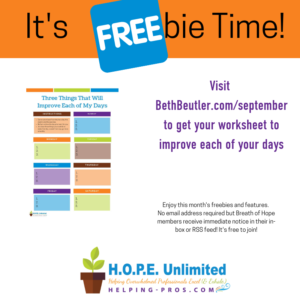Beth Beutler's Blog, page 4
September 20, 2019
Reply to … You: How to Make Your Emails More Respondable

Did they ever receive my email?
Have you ever asked yourself that?
Some people never seem to look at their email. It becomes a black hole. (Someone close to me who shall remain nameless is one of those people.) While you may resign yourself to accepting that a person isn’t responsive by email, it can be challenging when you need something from him or her and the work culture is one in which email is a standard form of communication. If that is the case, you’ll need to make your emails stand out. Here are ways you can do that:
Make the subject line do the work.
In many cases, the subject line is the key to whether your email will be given any attention. Create some agreed-upon conventions such as FYI (for your information) or RNT (response needed today) or AYC (at your convenience) in the subject line so that the recipients can more easily decide how to respond when they see it.
Example: RNT – Which sandwich do you want for lunch?
Be concise.
Keep the length to a point where the recipient doesn’t have to scroll much, if at all.
Example: The meeting has been changed to 1:00 pm and lunch will be provided. See you then. (No need to explain all the whys behind the change of time.)
Be warm.
Make your emails an enjoyable bright spot in the recipient’s day. You don’t have to add much, but a (sincere!) warm question or greeting can be effective in building an appreciative and warm culture.
Example: Can you meet at 1:00?
could be replaced with
Hi Beth,
Could you meet at 1:00 today? I’d love to hear your ideas!
Add a deadline.
If you need information by Friday, say so early in the email text, and when possible remind the recipient that it is to their benefit to answer in a timely way.
Example: In order to finish the weekly report before your vacation, I will need the information no later than Friday at 9:00 am.
Use multiple means to communicate.
An effective communicator uses multiple means to get a message across. Even if email is the primary method at your workplace, learn which people respond well to email, those that prefer a call, or those who keep up with their texts. While it can be frustrating to need to adapt to individual communication styles, it can often get you the results you need. Ironically, that saves you time in the long run.
Example: for the unnamed person above, I would follow up with a text or even mention something in passing to them in person.
Bribe them.
Yep, I said it. Have some fun with this.
Example (toward the closing of the email) There’s a treat in the breakroom for anyone who read this far!
State your alternative plan if they don’t respond.
Let the recipient know what will happen if you do not hear from them.
Example: If I do not receive any further information by Friday, I will assume you have nothing to add and will proceed.
This provides you a reasonable “out” for continuing the work and a “paper” trail for having effectively tried to communicate. Again, this is better if you’ve also tried some of the other ideas given, but sometimes, you just have to hold people responsible for their part in workplace dialog and not coddle them so much.
People say there is too much email, and they are right. Make yours stand out!
Image by Kate Stejskal from Pixabay
The post Reply to … You: How to Make Your Emails More Respondable appeared first on Beth Beutler.

September 10, 2019
Making Notifications Work for You

Ding. Ring. Popup and sing. Every day we handle a host of notifications on our devices.
Apps want to send us “push” notifications so we don’t forget to interact with them.
We are notified when a text, phone call, or email comes through.
We deal with that little number in the top right corner of the app icon climbing as more messages come in.
And all this contributes to feeling unsettled, distracted, and annoyed.
It’s time to take control. Here’s how.
Take responsibility. Most devices allow YOU to choose how you’ll be interrupted. We forget to control our devices and allow them to control us. Many apps default to wanting to notify you – that’s understandable because they want your interaction (and possibly your money.) But it’s time for YOU to step up and decide which apps and people have access to your precious time and mental space.
Only allow notifications for critical communication. Perhaps you want to know when texts or phone calls come in, but don’t really need to see emails immediately. Adjust your settings accordingly.
Disable notifications on apps you regularly visit. I am a member of a fantastic sports reporting site, but their app sends a lot of notifications throughout the day. Since I know I’m going to visit their site several times a week anyway, I can shut down the notifications or customize them for the things I most want to see right away – if anything. (If you know you go to the grocery store every Thursday, you don’t need the store to call you every day.)
Use DND features and apps. Your phone may already have DND settings (or “digital wellbeing” tools) but if not, there are apps and to help you stay focused. Search for what you need and implement it, especially if you find yourself tempted by the distractions of social media or games. Since I don’t have a landline, my smartphone stays on all the time. I use an app and the phone’s built-in feature for DND times (with gateways that only allow a few people to still ring or text through in case of emergency.)
Consider modifying your settings per device. It’s not unusual for us to use a phone, laptop, and desktop in our work, and possibly even a tablet. With having two to four devices, there’s really no need to have the same notifications popping up on all of them. Consider what apps you use most on each device and adjust your notifications accordingly. You may find you don’t really need many of them.
Notifications are a given if you use technology regularly. But it’s in your power to control them so they don’t control you. You’ll be glad not to have so many interruptions each day when you make them work for you, not you work for them.
Image by TeroVesalainen from Pixabay
The post Making Notifications Work for You appeared first on Beth Beutler.

September 1, 2019
Welcome to September, the Second New Year (and a Tip from Turbo)

 Hi all!
Hi all!
September (and even mid-to-late August) tends to have a “new year” feel, generally because, for many, it’s the start of a new school year.
I’m long past being part of the new school year rush now, but I still feel the energy of the start of new semesters and see the first day of school photos in my social media feeds. While I’m enjoying the season I’m in, I also kind of like the sense of structure a new school year brings to society as a whole (even though I can experience more traffic on our “rural” road that happens to lead to two schools!)
With the sense of new beginning that comes with September, it’s a good time to evaluate what works and what doesn’t in your routines. I’ve recently been journaling thoughts about choices that could make a Sunday better, a Monday better, etc. I’m thinking about what makes a particular day more stressful and what choices I can make to mitigate that.
For example, Mondays are “high power” days for me and my business. It’s usually the day I do the most for clients of any day of the week. It’s the day I’ll tend to have the most meetings, too. So I very rarely work anywhere but in my main office. I don’t make outside plans or appointments.
Monday is also a very full day for my husband and while we were chatting about Monday’s pattern, he suggested, “Why don’t we make Monday’s a fend-for-yourself night for dinner?” (I agree, and we’ll do it at least some Monday’s of the month. I may call it Make it Yourself Monday now because I have to have catchy ways to label processes.) That one change alone to improve a Monday could make a big difference.
That’s just ONE example of how I can make Mondays better and less stressful.
To help YOU think through each day of your week and what could improve it, this month’s freebie is a worksheet to help you jot down ideas unique to your week.
Last month’s poll asked how many hours a week you typically work. Those who answered indicated 21 or more hours a week, some 41 or more. That gives me an educated guess that readers and followers of HOPE Unlimited are both part and full-timers when it comes to their work. It doesn’t matter how many hours you work – you can always grow professionally and personally, and I’m glad I’m one of the sources you look to for that encouragement.
This month’s poll asks how long your lunch “hour” is. Looking forward to seeing your answers! And the featured service is our monthly Executive Virtual Assistance membership. Have you ever felt like you’d love to have an assistant, but can’t afford a full retainer package? This $40 a month membership could be perfect for you!
Check out the freebies, features and other fun on the September F&F&F page. Let me know how I can encourage you!
You’ll also notice a new button giving anyone the opportunity to make a donation if you appreciate the resources I provide through this blog, social media, free downloadables, free strategy sessions, etc. This service comes under the soft skills/stress management strategist portion of my business and is typically done on a volunteer basis at this point. Any donation is appreciated!
Here’s to a great fall. Thanks as always for reading and following!
Beth
PS: Turbo is growing and getting stronger! He’s now around ten weeks old and has about doubled in size! Here’s a “Turbo Tip” for you!

The post Welcome to September, the Second New Year (and a Tip from Turbo) appeared first on Beth Beutler.

August 20, 2019
50 Ways to Take a Five-Minute Break

It seems counterintuitive.
We have a to-do list a mile long, and yet we feel the need for rest.
But if we rest, we won’t apply ourselves to the to-do list.
How do you know if we should rest or not?
1. Listen to your body. It gives signals to share when you are over-tired. Are you yawning a lot? Feeling clumsy? Mentally scattered?
2. Consider your emotions. Are you irritable or short-tempered today? Are you being snippy with people?
3. Take a 5-minute break. You may not be able to take a nap at your job, but there are lots of ways to take a five-minute break. Consider these ideas, many of which came from one of my “Question of the Day” discussions on my personal Facebook profile:
Step outside, preferably in sunshine, and take several slow deep breaths (and then probably check my Facebook.)
Close my eyes and just breathe.
Sit still and stare into outer space.
Meditate on the Bible or other inspirational material.
Breathe, making a conscientious effort to exhale a little more deeply.
Play ping-pong with a co-worker.
Play a mindless game on my phone/tablet.
Dance.
Find a quiet place to sit, close eyes, and slow down breathing, clearing my mind.
Do part of a crossword puzzle.
Take a quick bike ride.
Sit and watch birds at a feeder.
Turn lights off in the office, close door and put head on desk (hoping not to fall asleep!)
Read part of a book I’m working through.
Do yoga or other forms of stretching.
Turn music up loud and dance/sing.
Walk outside.
Go find a beautiful view nearby.
Walk up and down a flight of stairs.
Stand on tiptoes.
Go out onto deck/patio/lanai.
Lay on floor and stretch, then wrestle with my dog that pounces on me.
Play with my kitten.
Walk 250 steps per hour (reminded by FitBit)
Get coffee.
Call a loved one to say “hi.”
Text or call a friend that I haven’t connected with for a while.
Write a thank-you note.
Make a fun flipbook drawing using a little post-it note pad.
Listen to a podcast.
Take the dog outside.
Refill water bottle.
Take a look at social media.
Play an instrument.
Color.
Have a healthy snack.
Wash a few dishes or do some cleaning.
Fold laundry.
Use the restroom and take time to breathe while there.
Journal.
Read an article/post by a favorite author or blogger.
Read to or play with a kid.
Do some food prep.
Tidy up my desk area.
Look through some inspiring photos.
Do some form of strength training.
Post something uplifting to social media.
Pray.
Do an act of kindness (i.e. give a tip to a service provider such as a security guard, public works/sanitation worker, etc.)
Focus eyes on a distant scene to give them a break.What would you add to this list?
Image by silviarita from Pixabay
The post 50 Ways to Take a Five-Minute Break appeared first on Beth Beutler.

August 10, 2019
A Full Voice Mail Box May Mean Lost Business

Have you ever called a business and received the recording, “The recipient’s voice mailbox is full”?
Uh oh.
That’s bad news for a business or organization that is trying to have a relationship with customers or potential clients.
A full mailbox is a “barrier to entry” for your customers, and it’s a competitive world. If they can’t get the information or answers they seek from you, they will probably go elsewhere.
How much business have you lost because someone couldn’t leave you a message?
Why do mailboxes even fill up? One main reason. We’re afraid to delete messages.
Maybe we think we will need the message later or will use the voice mail as a reminder to call people.
There is a better way.
Think of your voice mailbox as a bridge to relationships, not a filing cabinet. (Just like your snail mailbox … you don’t keep all your daily mail there, do you?)
Listen to a voice mail message, and if you can’t answer right then, at least put the info into a task management system (i.e. under “to call”) and once it’s safely captured, delete the message from your phone. Some voice mail systems may allow you to email the transcript to yourself, or if you have voice mail that transcribes, you could take a screenshot and email it so you can put it into a task management system instead.
Whatever system you come up with, keep that voice mailbox from filling up. You never know what great customer or donor just called someone else because they couldn’t leave you a message.
The post A Full Voice Mail Box May Mean Lost Business appeared first on Beth Beutler.

August 2, 2019
A New Kitten – 31 Hints – and more

Welcome to August! While for many, there are still plenty of “dog days of summer” left, there’s also a good deal of prepping for the fall. I don’t have to do school shopping anymore, but even back in July I saw people shopping for school supplies. And organizations/businesses are already thinking about routines and initiatives for the turn of the season.
This month’s freebie is a list of daily tips for the month of August. Perhaps some of these will inspire and encourage you as you craft your routines and choices going into the “second new year” of 2019.
July was a month of upheaval in some ways – some everyday things changed including the unexpected rescue of a kitten. My husband retrieved him out of the engine compartment of a car at work, and for the foreseeable future, he has a home with us. We didn’t expect to have any more pets for awhile, then Winkie started hanging out at our house, and Turbo came along. We don’t know how long term this two-cat relationship will be, so we are taking it one day at a time! You can follow the adventures of our cats on Instagram under the hashtag #beutlercats
Last month’s poll was about favorite office supplies. The top three favorites were technology, writing utensils and personal items.
This month, the poll is about how many hours a week you work. I’m using a new format that lets you see the results right away.
Be sure to visit the August Freebies, Features and Fun page to get your tips, click on the poll, and see other helpful info.
Have a great month and stay cool!
The post A New Kitten – 31 Hints – and more appeared first on Beth Beutler.

July 20, 2019
What is your MIT Today? Thoughts about Prioritizing

What is your MIT?
One of my clients encourages people to focus on the “Most Important Thing” each day–a principle shared in their book, Winning Well. Similar concepts are part of conventional business wisdom however you word them–essentially, it’s prioritizing.
I wrote about MIT some time ago here but it’s worth looking at again.
For some MIT means Most Important Thing. For others it means Most Important Task. But I got to thinking about other things it could mean, that may align better with some types of work. For example, since administration is a big part of my work, picking ONE most important thing/task can be difficult. How do you choose which client or project gets the appropriate attention when you have more than one?
So maybe, MIT can be thought of in other ways, such as…
Multiple Important ThingS
When you consider your MIT, it’s okay that there might be more than one. I recommend that you never have more than three MITs in your day, however. As you plan your time, consider up to three things that really must have your focus today. Be careful not to always pick these based on urgency, though. Our fast-paced world creates “emergencies” regularly, something we need to intentionally fight against.
Most Irritating Thing
Another approach is to choose the task you least enjoy doing and focus on doing that early in the day. You’ll feel both a sense of relief and accomplishment, and it will probably energize you for the rest of the items on the task list. For example, maybe you hate updating your checkbook, but if you do it once a week, and today’s the day, it saves a month (or more) worth of work in the future when it may become harder to find transactions or reconcile the account. (Side note, I reconcile my checkbooks once a week since dealing with numbers is not a natural strength for me. It’s easier to find something that’s off when there’s only a week of transactions.)
Most Influential Thing
What items on your task list will most move the needle of your goals today? What will have the most influence on the important ideas and values you want to live out? For example, maybe you are writing a book, and spending at least 15 minutes writing today will keep the process moving for you.
How about you? What should be your MIT for today, based on which meaning resonates with you the most?
Need help with prioritizing? Sign up for a free 30-minute strategy session here.
Image by mohamed Hassan from Pixabay
The post What is your MIT Today? Thoughts about Prioritizing appeared first on Beth Beutler.

July 10, 2019
What Can You Unsubscribe from Today? Some Questions to Help You Target the Emails to Ditch

Every day, overwhelmed professionals are inundated with emails. Some that arrive are well-meaning and designed to help you, like mine. Others are trying to sell you something. Others are (sometimes terrible) pieces of junk mail. And that’s not counting the emails that are actually from colleagues, clients, and customers.
You can try a variety of things (services that consolidate emails, or a separate email address for sales flyers/newsletters, courses that give you tips and tricks, or even a VA to sort your inbox.) But there is one thing you can consistently do that will eventually make a major difference in the amount of legitimate email you have to process.
Unsubscribe from one email per day.
How do you decide whether to unsubscribe from an email? Here’s are some questions to help you decide:
Why did I subscribe to this email in the first place? Is that reasoning still relevant?
Do I open and read this email 80% of the time, within three days?
Is the information in this email helpful and worth absorbing?
Can I get this information in another way (i.e. RSS feed reader, visits to their website when convenient to you, their social media pages)?
If the company suddenly stopped producing this email, would I miss it?
As a blogger who has subscribers, these are hard questions to suggest. It could very well mean that some of my own subscribers may decide to ditch “Breath of HOPE.” I hope they don’t, but because I’m coming to the realization that I absorb information from a variety of sources, an unsubscribe doesn’t mean lack of interest. And I try to put my blog out in various formats and places now because an important goal is to serve people where they are.
So go ahead. Apply the above questions to my blog. But make sure you also do it for others. Find one email a day you can unsubscribe from until what you receive is really what benefits you.
Image by Denis Bogdan from Pixabay
The post What Can You Unsubscribe from Today? Some Questions to Help You Target the Emails to Ditch appeared first on Beth Beutler.

July 1, 2019
Do You Like Your Work Space? Plus Results of Pets in the Office, July Freebies, and More

Do you enjoy the space in which you work? Maybe it’s a cubicle, or a home office, or a co-work spot. Perhaps you carry your “desk” essentials with you or have a fairly permanent set up at your employer’s location. Wherever you work, it’s important to have a set-up for comfort (ergonomically, too), motivation and productivity.
This month’s freebie is a worksheet with four simple questions to help you evaluate the workspace you use. Our one-question poll for the month allows you to pick three tools/items that help you have a pleasant and productive workday. It will be interesting to see what people will choose, and you now can see the results immediately after answering the question!
Last month, the poll was about pets in the workplace. I also used that topic as the Question of the Day on my personal Facebook page. (We have some great discussions there.) Perhaps surprisingly (and perhaps not) there were a few who weren’t convinced pets belong in a workplace. The results of our poll correlated, indicating there are a number of people who, while they may like animals, may not feel it’s a good idea to have them in the workplace. Some reasons include allergies or fears that people may have. That’s fair — sometimes animals do invade personal space even if the person hasn’t invited it.
The animals technically did win out though, as you can see from this graph:

In the end, no matter where you fall, remain courteous of those around you (and of your pet.)
Speaking of, here’s my Winkie, who sometimes hangs out in my office (but typically doesn’t.) Not sure she was thrilled I was taking her photo, but I bet she’s happy the CATS WON!

July’s one-question poll is about your favorite workspace tools/items.
The Refresh bundle focuses on Relationships this month, and the free sample is available on the July FFF page along with other tips and the poll for the month. Check it out!
I hope July is a “cool” month for you. And if you are getting hot under the collar due to stress in your work-life, let me help. Sign up for your free strategy session here.
Photo: My typical co-work set up when working at Endeavor Greenville.
The post Do You Like Your Work Space? Plus Results of Pets in the Office, July Freebies, and More appeared first on Beth Beutler.

June 20, 2019
How Do You Handle Difficult Feedback?

Three distinct times in my life and career, I received hard feedback with a common theme. I still look back on those times as fundamental parts of my vocational (and personal growth) despite the difficulty of receiving the feedback at the time.
Feedback comes in many forms, from “likes” on social media, to a conversation with your boss, to a passing comment by a friend.
In general, feedback can be a helpful tool as we grow professionally and personally. We all react in a unique way from it.
What is your most frequent response?
Don’t want it don’t need it. I make the rules for my life.
Pros: Your independence is inspiring. It’s very freeing to live life without worrying about what other people think.
Your freedom and confidence probably helps your creativity and productivity.
Cons: You could benefit greatly by being more open to feedback. You might receive insight you hadn’t considered, which will help you be even more effective in your work.
You might come across as arrogant and unapproachable, which could make your work life more difficult down the line (if not now) and may keep you from some very meaningful relationships, or increasing the vitality of friendships you already have.
Listen to all of it/take all of it to heart.
Pros: Your willingness to listen will serve you well. You can learn more when you listen, not blinded by your own view of yourself.
Others probably feel drawn to you, like you are an easy person to get along with.
Cons: If you take ALL feedback to heart you may take in some info that is either 1) just not true or is 2) somewhat true but presented in a hurtful way. The hurt may overcome what you could learn from the feedback.
You may also depend too much on the opinions of others instead of having confidence in knowing your own strengths and challenges.
Consider it thoughtfully, absorbing what I feel is helpful and applicable, and discarding what I feel was mean-spirited or even inaccurate.
Pros: This balanced approach will serve both you and the people around you. When you are open to considering what truths are encased in feedback (even feedback not presented effectively) you may learn something and if you have the humility to apply it, your coworkers will benefit as well. At the same time, you won’t be weighted down emotionally by feedback not presented with the right motives, because you can discern the valuable part and discard the rest.
Cons: not sure I see any. Do you?
Feecback can be helpful to all involved IF given and received in the right spirit.
The post How Do You Handle Difficult Feedback? appeared first on Beth Beutler.




